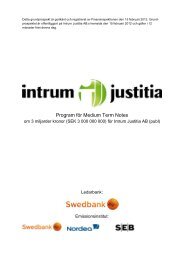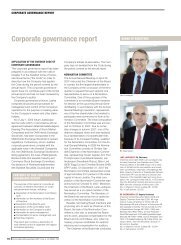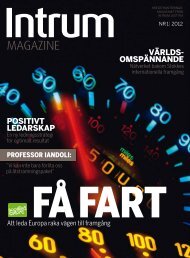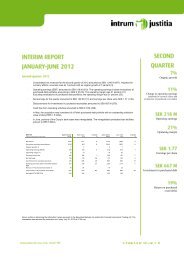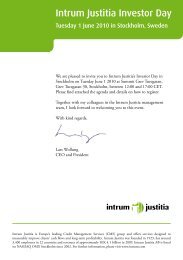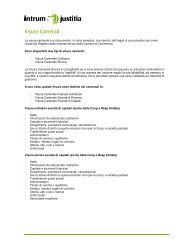You also want an ePaper? Increase the reach of your titles
YUMPU automatically turns print PDFs into web optimized ePapers that Google loves.
are made at the portfolio level, since each portfolio of receivables consists of a<br />
small number of homogeneous amounts. On the basis of the updated cash fl ow<br />
forecasts and original effective interest rate, a new book value for the portfolio is<br />
calculated in the closing accounts. Changes over time in the book value consist<br />
of a time and interest rate component and a component related to changes<br />
in estimates of future cash fl ows. Changes in cash fl ow forecasts are treated<br />
symmetrically, i.e., both increases and decreases in forecast fl ows affect the<br />
portfolios’ book value and, as a result, earnings. However, the portfolios are not<br />
recognized at a value higher than cost.<br />
Cash fl ow statement<br />
The cash fl ow statement is prepared according to IAS 7 Cash Flow Statements<br />
and includes changes in the balance of liquid assets. The Group’s liquid assets<br />
consist of cash and bank balances. Cash fl ow is divided into cash fl ows from<br />
operating activities, investment activities and fi nancing activities.<br />
Foreign subsidiaries’ transactions are translated in the cash fl ow statement at<br />
the average exchange rate for the period. Acquired and divested subsidiaries are<br />
reported as cash fl ow from investing activities, net, after deducting liquid assets<br />
in the acquired or divested company.<br />
Earnings per share<br />
Earnings per share consist of net earnings for the year (attributable to the Parent<br />
Company’s shareholders) divided by a weighted average number of shares<br />
during the year. Shares issued or redeemed during the year are included in the<br />
calculation from the date when the proceeds from the transaction are paid to or<br />
by <strong>Intrum</strong> <strong>Justitia</strong>.<br />
Since 2004 the Group has an employee stock option program for which the<br />
Parent Company has issued options to senior executives in the Group to subscribe<br />
for new shares. In 2005 the employee stock option program gave rise to<br />
a dilution effect on earnings per share calculated according to IAS 33 Earnings<br />
per Share. The dilution effect consists of the difference between the number of<br />
shares comprised by the option program and the number of shares at market<br />
value corresponding to the present value of future subscription proceeds.<br />
In 2004 the present value of the options’ strike price exceeded the average<br />
market quote for the year, due to which there was no dilution effect from the<br />
option program.<br />
Segments<br />
A segment is a part of the Group identifi able for reporting purposes that either<br />
supplies goods or services (business areas) or goods or services in a specifi c<br />
economic area (geographic region) exposed to risks and opportunities that differ<br />
from other segments.<br />
Segment information is provided in accordance with IAS 14 Segment<br />
Reporting for the Group only.<br />
<strong>Intrum</strong> <strong>Justitia</strong> considers geographic regions as its primary segments and<br />
service lines as secondary segments. The geographic regions are Sweden,<br />
Norway & Denmark; United Kingdom & Ireland; Netherlands, Belgium & Germany;<br />
Switzerland, Austria & Italy; Finland, Estonia, Latvia & Lithuania; France, Spain<br />
& Portugal and Poland, Czech Republic, Slovakia & Hungary. The distribution is<br />
based on where clients are located. The service lines are Consumer Collection<br />
& Debt Surveillance, Commercial & International Collection, Purchased Debt<br />
and Other services. In addition, there are central expenses that are not<br />
distributed by geographic region or service line.<br />
The distribution by geographic region and service line conforms to the<br />
segment distribution used for internal Group follow-ups. Key ratios such as<br />
number of employees, number of cases and revenues are used when<br />
distributing expenses in a Group company between service lines.<br />
Parent Company’s accounting principles<br />
The Parent Company has prepared the annual report according to the Annual<br />
Accounts Act (1995:1554) and the Swedish Financial Accounting Council’s<br />
recommendation RR 32 on reporting by legal entities. RR 32 means that the<br />
Parent Company in the annual report for the legal entity must apply all EUapproved<br />
IFRS and pronouncements as far as possible within the framework<br />
of the Annual Accounts Act and taking into account the connection between<br />
reporting and taxation. The recommendation specifi es exemptions and additions<br />
relative to IFRS.<br />
Differences between the Group’s and Parent<br />
Company’s accounting principles<br />
Differences between the Group’s and Parent Company’s accounting principles<br />
are indicated below. The accounting principles for the Parent Company as stated<br />
below have been applied consistently to all periods presented in the Parent<br />
Company’s fi nancial reports.<br />
Subsidiaries, associated companies and joint ventures<br />
Shares in subsidiaries, associated companies and joint ventures are recognized<br />
by the Parent Company according to the acquisition value method. Revenue includes<br />
only dividends received, provided that they stem from profi ts earned after<br />
acquisition. Dividends exceeding those earnings are considered a repayment of<br />
the investment and reduce the carrying amount of the shares.<br />
Long-term monetary balances<br />
Long-term monetary balances between the Parent Company and independent<br />
foreign operations that represent an expansion or reduction in the Parent<br />
Company’s investment in the foreign operations are carried in the Parent<br />
Company at historical exchange rates.<br />
Group contributions and shareholders’ contributions for legal entities<br />
The company reports Group contributions and shareholders’ contributions in<br />
accordance with the pronouncements of the Swedish Emerging Issues Task<br />
Force. Shareholders’ contributions are recognized directly in the shareholders’<br />
equity of the recipient and capitalized in the shares and participating interests of<br />
the contributor, to the extent impairment is not required. Group contributions are<br />
recognized based on their economic intent. This means that Group contributions<br />
paid in order to minimize the Group’s total taxes are recognized directly in<br />
retained earnings after deducting the current tax effect.<br />
Group contributions equated with dividends are recognized as a dividend.<br />
This means that Group contributions received and the effect on current tax are<br />
recognized through profi t or loss. Group contributions paid and the effect on<br />
current tax are recognized directly in retained earnings.<br />
Group contributions equated with shareholders’ contributions are recognized<br />
by the recipient directly in retained earnings taking into account the effect on<br />
current tax. The contributor recognizes the Group contribution and its effect on<br />
current tax as an investment in shares in Group companies to the extent impairment<br />
is not required.<br />
Other<br />
The Parent Company has no leases classifi ed as fi nance leases either in its own<br />
accounts or the consolidated accounts. Nor does the Parent Company have<br />
any pension obligations recognized as defi ned benefi t plans either in its own<br />
accounts or the consolidated accounts.<br />
Financial instruments are carried at fair value in the Parent Company only if<br />
permitted by the Annual Accounts Act.<br />
45





